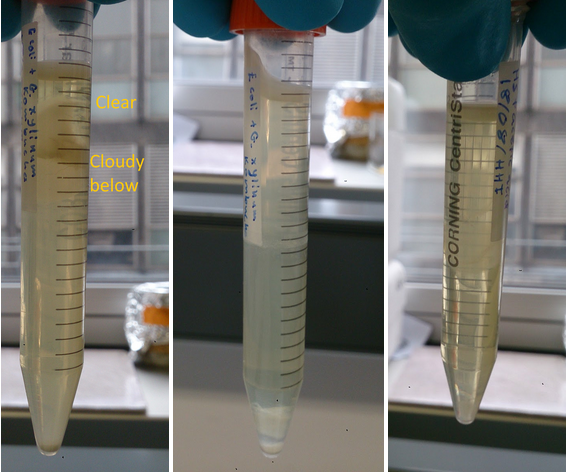Team:Imperial/coculture
From 2014.igem.org
RFP E. coli and G. xylinus iGEM Co-Culture
Overview
Key Achievements
Introduction

The idea of combining E. coli as an efficient cloning organism since it has the largest library of well characterised parts available and G. xylinus as a robust efficient cellulose producing host came about as a way to take advantage of the characteristics of each host. E. coli DH10B has a very short division time of 30 min whereas the Kombucha Isolated Gluconacetobacter strain has been producing bacterial cellulose robustly in a co-culture with yeast. For these reasons, the aim was to have E. coli produce customisable proteins of interest such as metal binding phytochelatin, linked to cellulose binding domains (CBD), simultaneously with cellulose being produced by G. xylinus allowing these proteins to attach to the material, effectively making it a 1 step functionalisation.
In a co-culture of the cellulose-producing and protein-producing species there will be competition for resources and space, and potentially also a symbiosis of some kind. The main hypothesis of this co-culture experiment is that G. xylinus would orient itself in the oxygen rich layers towards the top of the media due to being an obligate aerobe as explained in the BC synthesis pathway section whereas E. coli would orient itself throughout the media but expectedly have a higher concentration in the oxygen depleted bottom media.
In order to have a stable co-culture, at least in the timescales we are conducting our growth and functionalisation, we need to identify potential interactions and regulate the growth of each species. The main variable identified for the interactions was identified as the carbon source of the HS media used, which requires an initial experiment that can inform the choice/combination of carbon source(s) used for the actual experiment containing E. coli with an Anderson promoter controlled RFP gene (J23104) in J61002 and the Kombucha Isolated strain.
Methods
In terms of measurements, the doubling rate of E. coli of 30 min whilst the doubling rate of G. xylinus is approximately 8 hours, which means that by far the major contribution to total population, and so OD600, is E. coli. Therefore, the OD600 will be used as an indication of the E. coli level in the media. For G. xylinus, the pellicle is assumed to be a direct indication of the population of G. xylinus. Triplicates were used for all carbon feedstocks and HS media was prepared according to the G. xylinus HS media and culturing protocol. A 2 %w/v concentration of carbon source was used. The Kombucha media was prepared according to the Kombucha growth protocol.
15 ml Falcon tubes were inoculated with 12 ml of media, the samples were seeded with a small solid seed of pellicle of the G. xylinus iGEM strain. Lids were kept loosely unscrewed to allow aeration, and samples were incubated at 30°C static. Triplicates were used for all carbon feedstocks and a control of unseeded media was incubated alongside the samples.
Results

Based on the results depicted in figure 2, feedstocks that allowed growth of both E. coli and G. xylinusE. coli in the media. Figure 2 b) depicts reasonable in G. xylinus growth in glucose, acetic acid, glucose & glycerol 50/50 combination and glycerol. Taking this data into account, glucose & glycerol would be the best candidates for a co-culture. However, the optimum ratio of glucose to glycerol has not been discovered, so 6 combinations of glycerol to glucose ratios were used: 100/0, 80/20, 60/40, 40/60, 20/80 and 0/100.

References
 "
"











